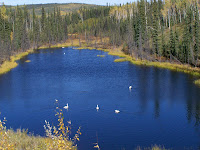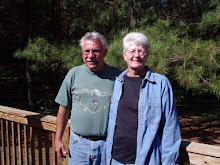Deadman Lake Revisited
Pas

sing through Tok we realized that a lot of the summer visitors have departed already. The

businesses are still operating but on a limited schedule and the terrain all along the highways the last few days show signs of summers end.
Arriving at Deadman Lake brought back a lot of good memories from

the beginning of our time in Alaska -

wildlife teeming, lots of birds and waterfowl and beautiful wildflowers edging the roads. Alas, the lake hasn't changed much other than the fact there are very few birds and waterfowl and the level of the lake has dropped. The campsite we liked was empty as were most of the campsites.
The first night in the campground we went up for the ranger talk which was led by Cora Demit - an Athabaskan Indian Woman who is the Senior Ranger and a Tribal Council Member. She talked about life on the wildlife refuge and how the natives have survived throughout the years. She was a very interesting woman and we learned a lot about the Athabaskan Culture.
The second day there we went to the Indian Village - Northway Village - about 10 miles from the campground. The road into the village is narrow and winding, traveling over streams and barren land. The village itself is very small and most of the houses are of the same style and construction - a square structure up on stilts. Some of them larger than others but for the most part looked from the outside only 4 rooms to a house. Most of them still had outhouses as they have no sewer system. I did not take any pictures out of respect for their culture and privacy. We stopped at the post office and talked to a young woman there - Cherie Merandi - who gave us a lot of information about the drug and alcohol problem and how the Athabascan tribe is trying to help their people get away from that temptation. She also told us about the job situation in Alaska and about what her kids experienced working on the North Face. He daughter worked cleaning the rooms and showers for over $100 a day. Her son worked there laying pipe and whatever else they do for double that amount. Not too bad if you want to work. The people that work on the North Face work for 2 weeks and they are off 2 weeks. The mode of transportation in and out of the area is by plane and most of the workers live in the lower 48 states. They make good money but it is hard work and dangerous. Cherie was kind enough to show us her beading skills. She is making a rifle strap and it was beautiful work. Certainly peaked my interest.
The second night the ranger talk was led by Cheryl - another Athabaskan Indian woman - and
she talked abo

ut the plantlife in the wildlife refuge. She brought us Labrador Tea plants and spruce branches and instructed us on how to make the tea. She said that her mother drinks a cup a day and has her whole life and that is what keeps her healthy. She gave me the plants she had brought - we were the only ones there - and of course I had to make the tea. She said if I could find some cranberries I could put that into the mix too - so I did. I will say this for the mix - it definitely made our trailer smell good what with the spruce branch in it. Ken drank the tea and liked it - I thought it tasted like pine sap. After a couple of glasses of the tea Ken suggested we add some water to it as perhaps it was too strong so I did and it made it much more palatable.
Th

e third day we went on a hike to Hidden Lake. Along the way we spotted low bush cranberry plants, loaded with berries and decided we would p

ick on the way back. This trail is about 1 mile long and a lot of it is on constructed boardwalks because of the low areas that fill with water. The lake is small but we spotted beavers working diligently to supply food to the beaver family for the winter. There were tw

o adults swimming back and forth bringing branches with t

hem on the return trip and the kits - baby beavers - were practicing their skills maneuvering in the water - diving, playing and just swimming. They were so cute!! On the way back we did stop and pick cranberries - these low bush cranberries are actually loganberries - much smaller than the bog cranberries that we are familiar with. We also picked a few left over blueberries and ate them as we picked.
The third night ranger talk was given by Sylvia. She talked to us about "Potlatch" which is what they call their beading. She was very informative and told me she would give us some moose if she had any left in her freezer along with some whitefish preserved the native way if we came to the visitor's center the next day.
We did go to the visitor's center for Tetlin National Wildlife Park the next day and Sylvia blessed us with 4 slabs of fish and a large piece of moose tenderloin. Can't wait. While at the center, Cheryl took me to the demonstration table and showed me how they do their beading. Guess I will have to make a trip to a bead supply place - which she told me where to go - and buy some supplies.
All in all, the last 4 days have been wonderful. The nights are getting cooler and the lake is getting quieter with the waterfowl that was there starting their migration. We will remember Deadman Lake with wonderful memories and look forward to again spending time on the next trip.

This is the only moose we have seen in the last two weeks. A planter on the porch of the Tetlin National Wildlife Refuge Visitors Center











































